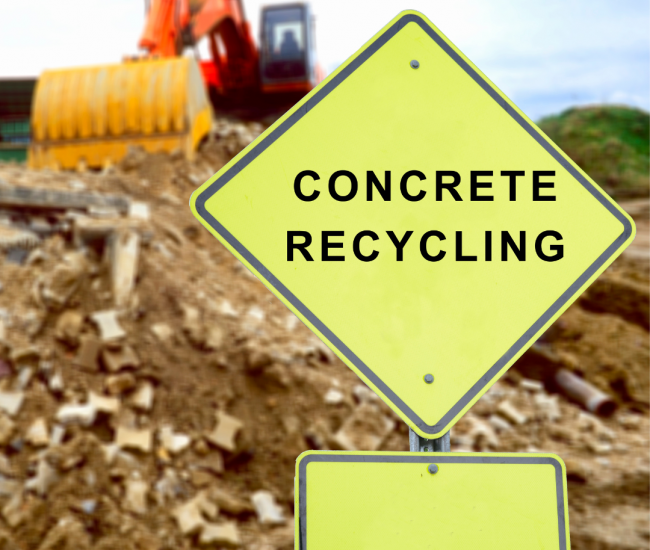More than just a mantra; it’s a way of life. Among the myriad materials primed for reincarnation, recycled concrete stands out as a versatile gem, offering boundless potential for innovative repurposing. As structures age or urban landscapes shift, the removal of concrete often leaves behind a trail of rubble, seemingly destined for the landfill. However, within this rubble lies a treasure trove of opportunity waiting to be unearthed. In this exploration of sustainability and creativity, we delve into the transformative journey of recycled concrete. Beyond its conventional use as a building material, we uncover a myriad of inventive applications that breathe new life into discarded concrete. From architectural marvels to eco-friendly landscaping solutions, the possibilities are as diverse as they are inspiring. Join us as we embark on a journey to reimagine, repurpose, and revive through the innovative reuse of recycled concrete.
Are you looking to breathe new life into your garden while also making eco-friendly choices? Recycled concrete might just be the solution you’ve been seeking. Beyond its traditional role in construction, recycled concrete can be repurposed in imaginative ways to enhance the beauty and functionality of your outdoor space. In this article, we’ll explore five creative uses for recycled concrete that will transform your garden into a sustainable sanctuary.

One of the most popular ways to use recycled concrete in garden design is by creating charming pathways. Break up larger pieces of recycled concrete into smaller, irregular shapes, and arrange them to form meandering paths through your garden. Not only does this add visual interest, but it also provides practical walkways that prevent soil compaction and erosion. For a rustic touch, fill the gaps between the concrete pieces with gravel or moss.
Another delightful way to incorporate recycled concrete into your garden is by crafting personalized stepping stones. Simply pour concrete into molds of various shapes and sizes, adding decorative elements like pebbles or mosaic tiles for added flair. These custom stepping stones not only add a whimsical touch to your garden but also serve as functional accents, guiding visitors along designated pathways.
If your garden features uneven terrain or sloping landscapes, recycled concrete can be used to construct sturdy retaining walls. Stack layers of broken concrete pieces to create retaining walls that not only prevent soil erosion but also serve as visually striking focal points in your garden. For a more polished look, consider applying a coat of concrete sealant or paint to enhance durability and aesthetics.
Elevate your gardening game by building raised garden beds using recycled concrete blocks or slabs. These raised beds provide better drainage, soil aeration, and weed control, resulting in healthier plants and higher yields. Arrange the concrete blocks in any configuration you desire, whether it’s simple rectangular beds or more intricate designs, and fill them with nutrient-rich soil for bountiful harvests year-round.
Define the boundaries of your garden beds and add structure to your landscaping with recycled concrete borders. Lay concrete pieces horizontally or vertically along the edges of your flower beds, vegetable patches, or lawn areas to create visually appealing borders that complement the natural beauty of your plants. Experiment with different shapes, sizes, and arrangements to achieve the desired aesthetic for your garden.
When it comes to constructing or renovating your driveway, sustainability may not be the first thing that comes to mind. However, with the rise of eco-conscious practices, using recycled materials like concrete can offer numerous environmental and practical advantages. In this article, we’ll delve into the benefits of opting for a sustainable driveway made from recycled concrete, providing a durable and environmentally friendly solution for your home.
Traditional concrete production involves the extraction of raw materials like limestone and sand, leading to habitat destruction and depletion of natural resources. In contrast, recycled concrete utilizes crushed concrete from demolished structures, diverting waste from landfills and reducing the demand for new raw materials. By choosing recycled concrete for your driveway, you’re making a positive impact on the environment by conserving resources and minimizing carbon emissions associated with concrete production.
In addition to its environmental benefits, recycled concrete driveways can also be more cost-effective compared to traditional concrete or asphalt options. Since recycled concrete is sourced from existing materials, the overall cost of production is lower, resulting in potential savings for homeowners. Additionally, the durability and longevity of recycled concrete driveways can translate to reduced maintenance and repair expenses over time, further enhancing their cost-effectiveness.
Recycled concrete may be eco-friendly, but it doesn’t compromise on durability or strength. In fact, recycled concrete driveways are known for their resilience and longevity, capable of withstanding heavy loads and fluctuating weather conditions. The inherent strength of recycled concrete makes it an ideal choice for driveways, ensuring years of reliable performance without the need for frequent repairs or replacements.
Despite its origins as recycled material, concrete driveways offer versatility in design, allowing homeowners to customize the appearance to suit their preferences and aesthetic preferences. Whether you prefer a traditional smooth finish or a decorative stamped pattern, recycled concrete can be molded and textured to achieve various looks. Additionally, you can choose from a range of colors and aggregates to enhance the visual appeal of your driveway, adding curb appeal to your home.
The heat island effect refers to the phenomenon where urban areas experience higher temperatures due to the absorption and retention of heat by buildings and paved surfaces. Traditional asphalt driveways contribute to this effect by absorbing and radiating heat, resulting in elevated temperatures in surrounding areas. Recycled concrete driveways, however, offer a solution by reflecting more sunlight and absorbing less heat, helping to mitigate the heat island effect and create a cooler environment.
In today’s eco-conscious world, finding sustainable solutions for home renovations is more important than ever. One innovative approach gaining traction is the incorporation of recycled concrete into remodeling projects. By repurposing concrete from demolition sites, homeowners can not only reduce waste but also add unique and environmentally friendly elements to their homes. Let’s explore how recycled concrete can transform home renovations from ordinary to extraordinary.
JUNKAHAULICS – Raleigh presents an innovative approach to repurposing recycled concrete post-removal, highlighting the importance of sustainability in construction practices. By embracing creative methods for reusing concrete waste, such as transforming it into decorative elements for landscaping or constructing new structures, businesses like JUNKAHAULICS not only reduce environmental impact but also contribute to the circular economy. Through their commitment to finding inventive solutions, they exemplify how even seemingly discarded materials can be valuable resources when approached with creativity and foresight, ultimately paving the way for a more eco-conscious future in the construction industry.


JUNKAHAULICS